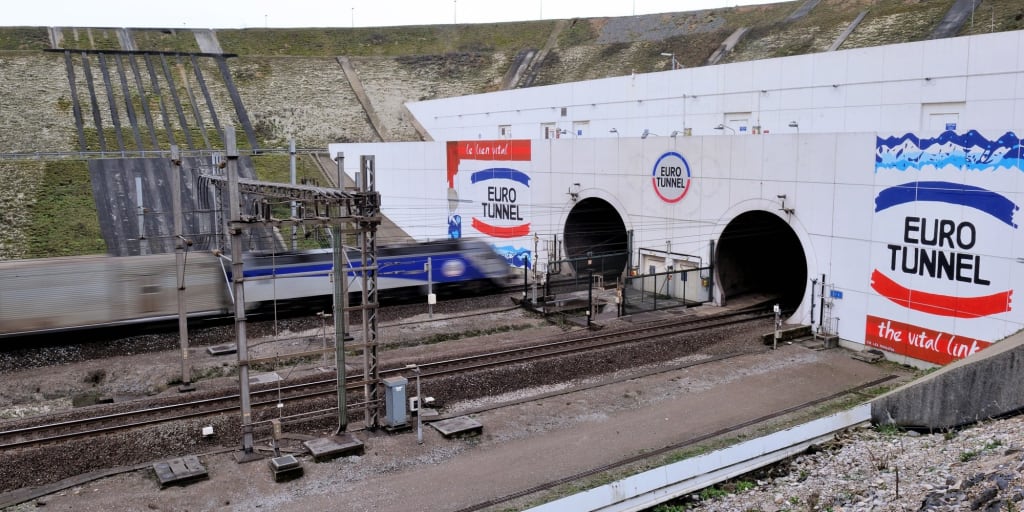The Channel Tunnel
The latest way to travel between the UK and France

The Channel Tunnel that connects England to France is one of the engineering marvels of the age. However, it has had a long and troubled history.
A stop-start project
The first proposal for a fixed link by tunnel between the two countries was made as far back as 1751, when a French farmer named Nicolas Desmaret came up with the idea. However, it was not 1802 that anyone took it seriously. Again it was the French who proposed making such a connection, but when war broke out between the two countries in 1803 the plan was put firmly on the shelf.
Suggestions were made several times during the 19th century, but it was not until 1875 that anything actually happened. It was in that year that the British and French governments passed laws to enable work to start, and this began in 1878 with borings on both sides of the Channel.
However, public opinion took against the idea in 1882, when people in Britain got the notion that the French could not be trusted not to use the tunnel to mount an invasion of Great Britain. The work that had already been done was therefore abandoned.
During the 20th century there were several proposals to revive the idea, and in 1967 it looked as though something would actually happen when the British government invited interested companies to submit firm plans for how they would get to work. However, hopes were again dashed when, in 1975, the then government changed its mind on grounds of cost.
At long last, real progress is made
The first move that would actually lead to the tunnel being built was in 1984, when an agreement in principle was reached at an Anglo-French summit. A treaty was signed in 1986 and work started in November 1987.
Boring was begun on both sides of the Channel with three tunnels being constructed – two rail tunnels and a service tunnel. It was the latter tunnel that first achieved breakthrough when the tunnelers from each side met under the Channel in December 1990. The two rail tunnels reached the same stage in May and June 1991.
The Queen and President Mitterrand officially inaugurated the tunnel on 6th May 1994, with the first rail services beginning in November of that year.
A tunnel for trains only
It is impossible to drive a car through the Channel Tunnel because it is designed for rail traffic only. This is of two kinds, namely passenger services by Eurostar and car and lorry transport on specially designed Shuttle wagons that allow drivers to drive on to the train at one end of the tunnel and drive off at the other. By contrast, the Eurostar services take passengers all the way from London to either Paris or Brussels.
This arrangement is mainly due to the fact that the tunnels are of relatively narrow bore; in order to get two or more lanes of road traffic through a tunnel you would need something considerably larger than the 24 feet (7.3 metres) of diameter that each of the two rail tunnels has. By contrast, the Queensway road tunnel under the River Mersey has an internal diameter of 44 feet, but it is only just over two miles long as against the 31 mile length of the Channel Tunnel.
Was it worth the money?
The Channel Tunnel project cost a huge amount of money, with the original estimate of £2.6 billion proving to be way below the final cost. The official final cost was £4.6 billion, but several sources reckon that this is a gross under-estimate, with a figure of £8 billion being given some credence.
Operating costs are high, such that the original investors (both public and private) do not expect to see a return on that investment for some considerable time.
In 2013 more than 20 million passenger journeys were made through the tunnel – split almost evenly between Eurostar and Shuttle services. However, there are other ways of crossing the English Channel, namely ferries and low-cost air services, and these have not been badly hit by the existence of the tunnel, which is therefore operating below its full capacity. Much commercial traffic still operates via the ferries, which are far from having been put out of business by the tunnel, as was originally expected in some quarters.
The question then arises as to what has been gained by constructing the tunnel. It was certainly a major engineering triumph and one of the “wonders of the modern world”, but one would have to compare the situation before and after the tunnel opened in order to judge whether the benefits outweigh the costs.
From an individual’s perspective the judgment probably depends on whether one prefers to travel under the Channel, across it or above it. At least one now has the full range of choices!
About the Creator
John Welford
I am a retired librarian, having spent most of my career in academic and industrial libraries.
I write on a number of subjects and also write stories as a member of the "Hinckley Scribblers".






Comments
There are no comments for this story
Be the first to respond and start the conversation.